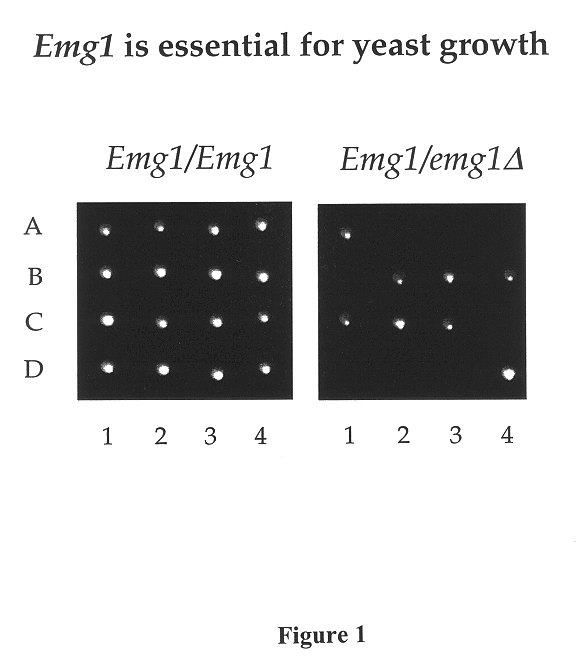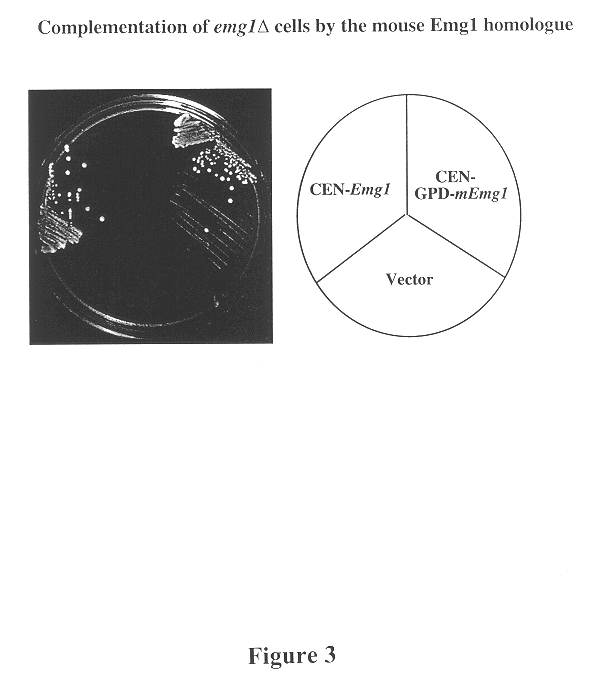Yeast mammalian regulators of cell proliferation
a technology of cell proliferation and mammalian cells, applied in the field of yeast mammalian cell proliferation regulators, can solve the problems of deregulation of growth and disease states, devastating consequences for cells, tissues and organisms, and negatively interfering with host processes, and achieves greater consistency between experiments
- Summary
- Abstract
- Description
- Claims
- Application Information
AI Technical Summary
Benefits of technology
Problems solved by technology
Method used
Image
Examples
example i
Identification, Isolation and Characterization of Emg1
In this example, a novel gene in the budding yeast Saccharomyces cerevisiae called Essential for Mitotic Growth 1 (Emg1) which encodes a protein of 252 amino acids was identified, isolated, and characterized. The sequence of this protein is unique within the S. cerevisiae genome. Computer-aided searches of known databases for homologous genes in other organisms has revealed the presence of highly similar genes in fission yeast, worm, rice, mouse and humans suggesting that the structure and potential function of the Emg1 protein is evolutionarily conserved. Except for these highly similar homologues, this protein does not align with any significant homology to any other described or sequenced protein or characterized protein functional domain. The lack of similarity suggests that this protein may define a new class of protein with an unique cellular function.
To understand the function of the Emg1 protein, S. cerevisiae cells, deno...
example 2
Identification and Isolation of Emg1 Structural and Functional Homologues
In this example, we investigate a number of feasible strategies for the identification and isolation of complementary DNAs from other organisms, such as plants, pathogenic fungi, cattle and so forth, encoding proteins that are functionally homologous to the S. cerevisiae Emg1 protein. These approaches include: 1) the use of DNA sequence database searches to identify cDNAs encoding Emg1 homologues 2) the use of the S. cerevisiae, worm, mouse, human or other existing genes or cDNAs encoding Emg1 as probes in hybridization assays to identify homologous DNA fragments 3) the use of complementation in Emg1.DELTA. yeast cells by the introduction of complementary DNA libraries under the control of DNA sequences that drive expression of the cDNAs in yeast cells. 4) The use of degenerate oligonucleotides as radioactive hybridization probes or in polymerase chain reactions to identify genomic DNA or cDNA fragments encodin...
example 3
Screens for Compounds that are Antagonistic or Agonistic to Proliferation
In this example, we investigate the use of Emg1 and derivative products as reagents to screen for anti-proliferative and pro-proliferative agents. Emg1 protein is essential for mitotic cell growth in yeast cells. Given the sequence similarity and functional complementation by mammalian Emg1 proteins it is likely that Emg1 is also of general importance in cellular proliferation in mammals, including humans, and is therefore a target for the action of molecules that modify cell proliferation. Such molecules will include antibodies, chemicals, RNA aptamers and other small molecules that neutralize, antagonize or promote the activity of Emg1. Additionally, such molecules might interfere with or enhance the interactions between Emg1 protein and other cellular molecules essential for Emg1 protein action in cell cycle progression. In one such assay, yeast cells are transfected with vectors encoding human Emg1, yeast E...
PUM
| Property | Measurement | Unit |
|---|---|---|
| Tm | aaaaa | aaaaa |
| Tm | aaaaa | aaaaa |
| temperature | aaaaa | aaaaa |
Abstract
Description
Claims
Application Information
 Login to View More
Login to View More - R&D
- Intellectual Property
- Life Sciences
- Materials
- Tech Scout
- Unparalleled Data Quality
- Higher Quality Content
- 60% Fewer Hallucinations
Browse by: Latest US Patents, China's latest patents, Technical Efficacy Thesaurus, Application Domain, Technology Topic, Popular Technical Reports.
© 2025 PatSnap. All rights reserved.Legal|Privacy policy|Modern Slavery Act Transparency Statement|Sitemap|About US| Contact US: help@patsnap.com



